Three Health Scares in Pablo Group in Two Weeks
By Gorilla Doctors Staff on Monday, June 11th, 2012 in Uncategorized.After an extremely quiet spring with no veterinary interventions in Uganda, DRC, or Rwanda, June brought the Gorilla Doctors a flush of new veterinary cases—three in Rwanda’s Pablo group in alone. Pablo, the biggest habituated group in the Virunga Massif with 44 members, has had its fair share of health problems over the years, but three unrelated health scares in less than two weeks is highly unusual.
Drs. Dawn and Jean-Felix report on the cases:
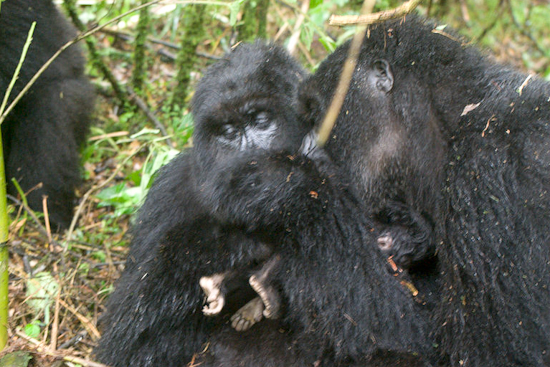 Mukecuru holds her dead infant.Mukecuru
Mukecuru holds her dead infant.Mukecuru
From Dr. Dawn: On May 20, Karisoke Research Center requested a health assessment of a 9-day-old infant born to Mukecuru, an elderly female in Pablo group. The infant was reported to be crying and weak. Sadly, the infant was dead when we arrived the next day. Mukecuru continued to carry the body and no visual abnormalities could be appreciated. Because she kept the deceased infant to her breast with her arms folded, it was not possible to observe her mammary glands during our visit. However, trackers reported the subsequent day that her mammary glands appeared to be flat with little to no milk. This is the third infant Mukecuru has lost in four years.
During my visit on May 21, Mukecuru herself appeared to be in good health, moving and eating normally. This is in contrast to the lethargy and weakness observed when she lost her last infant in 2009.
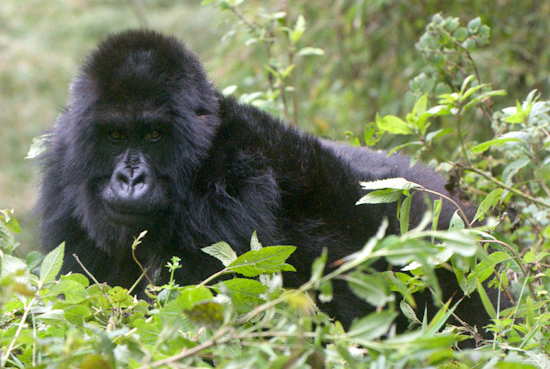 A weak Mukecuru lays on her stomach.From Dr. Jean-Felix: On June 2, Karisoke Research Center trackers reported that Mukecuru was lethargic, not eating, and lagging behind the rest of the group. The following day Volcanoes National Park Veterinary Warden Elisabeth Nyirakaragire, a team of Karisoke Research Center trackers, and I traveled to Pablo group to perform an intervention on Mukecuru.
A weak Mukecuru lays on her stomach.From Dr. Jean-Felix: On June 2, Karisoke Research Center trackers reported that Mukecuru was lethargic, not eating, and lagging behind the rest of the group. The following day Volcanoes National Park Veterinary Warden Elisabeth Nyirakaragire, a team of Karisoke Research Center trackers, and I traveled to Pablo group to perform an intervention on Mukecuru.
We arrived at the group at 9 am and saw all of the group members except Mukecuru. After some searching, trackers found her alone, 50 meters away from the others. Elisabeth and I observed her for 2 hours. She was laying on her stomach and very lethargic. Her respiratory rate was fast and her gums and mouth appeared pale. Her breasts looked entirely empty and her abdomen was flat—she had not eaten in a few days. She also had watery diarrhea.
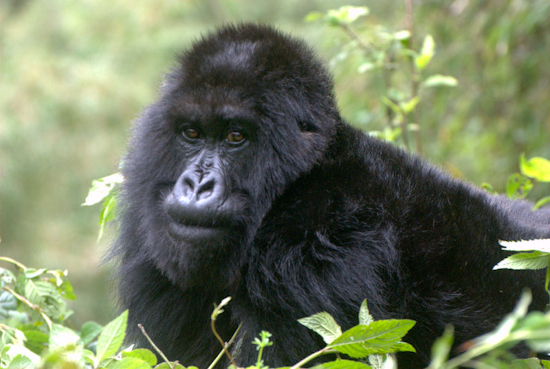 MukecuruWe decided to dart her with 1 gram of the antibiotic Ceftriaxone and 75 mg of the anti-inflammatory Ketoprofene. She was darted on the right thigh and didn’t cry out. We attempted to herd her back towards the group and she yowled at us, but eventually found her way to Cantsbee, the group’s leading silverback. She looked much more calm once she was back with the group. In the days that followed, Mukecuru gradually recovered her strength and began eating normally and moving with the rest of the group.
MukecuruWe decided to dart her with 1 gram of the antibiotic Ceftriaxone and 75 mg of the anti-inflammatory Ketoprofene. She was darted on the right thigh and didn’t cry out. We attempted to herd her back towards the group and she yowled at us, but eventually found her way to Cantsbee, the group’s leading silverback. She looked much more calm once she was back with the group. In the days that followed, Mukecuru gradually recovered her strength and began eating normally and moving with the rest of the group.
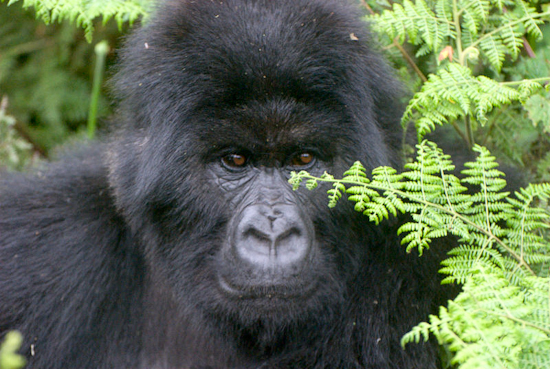 Turimaso
Turimaso
Turimaso
From Dr. Jean-Felix: On June 4, the day after the Mukecuru intervention, Turimaso, a 9-year-old female gorilla from Pablo group, was caught in a snare attached to a tree. Karisoke Research Center trackers tried to cut the rope snare from the tree but they were charged repeatedly by silverback Gicurasi who was protecting Turimaso. Fortunately, Turimaso chewed off the rope from the tree (but with the snare still around her wrist) and she was able to rejoin the group. Because the gorillas were so aggressive and agitated, we decided to try to remove the snare the following day.
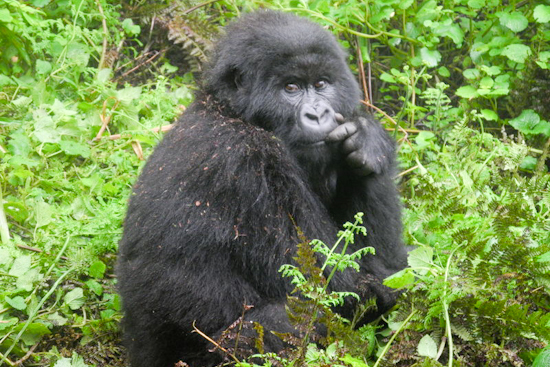 Turimaso avoids using her right hand.The next morning, Drs. Eddy, Noel, and I along with Elisabeth and a Karisoke team arrived at the group around 9 am. Trackers noticed that the snare was gone from Turimaso’s wrist. It was difficult to get close to her as Gicurasi was shielding her from our view and it was raining. After 1 hour we were able to observe Turimaso well, who was using only her left hand when moving and eating. Her right hand was slightly swollen but she was calm and ate abundantly. We decided to give her some time and see if the right hand could regain normal functioning after a period of rest.
Turimaso avoids using her right hand.The next morning, Drs. Eddy, Noel, and I along with Elisabeth and a Karisoke team arrived at the group around 9 am. Trackers noticed that the snare was gone from Turimaso’s wrist. It was difficult to get close to her as Gicurasi was shielding her from our view and it was raining. After 1 hour we were able to observe Turimaso well, who was using only her left hand when moving and eating. Her right hand was slightly swollen but she was calm and ate abundantly. We decided to give her some time and see if the right hand could regain normal functioning after a period of rest.
On June 6, Karisoke trackers reported that Turimaso was keeping up with group and eating well, although still not using her right hand. By June 10, Turimaso had regained full use of her right hand.
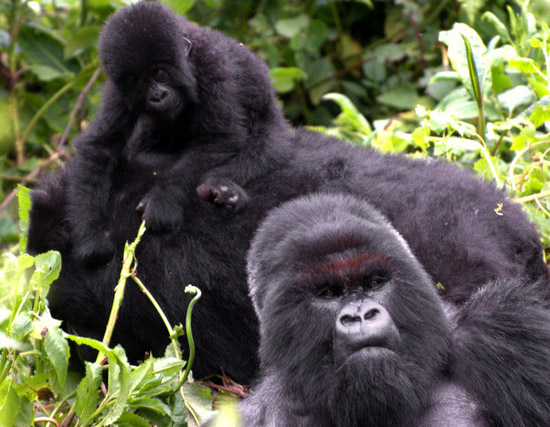 Cantsbee with family members.
Cantsbee with family members.
Cantsbee
From Dr. Jean-Felix: Silverback Cantsbee, the group’s leader since 1994 and one of the oldest gorillas in the park, was reported to be very ill on June 13. Karisoke Research Center trackers said that he was bleeding profusely from the anus. Dr. Mike and I prepared to perform a full intervention the next day. This would be challenging as the group is very large with several very aggressive silverbacks.
One June 14 we went to Pablo group and were surprised to find Cantsbee active, eating well, and behaving normally. Some blood clots were observed in his dung, but otherwise he appeared well, so the team made the decision not to intervene. As Cantsbee is the dominant silverback, we did not want to seriously disrupt the group by sedating their leader if it was not absolutely necessary. We will continue to follow his case closely and be prepared to act if his health changes suddenly.
You can follow the Gorilla Doctors health monitoring efforts on our Facebook page, where we post photos and notes from our monthly visits.
Please consider supporting MGVP by making a secure online donation. Every dollar you give goes to directly supporting our gorilla health programs and One Health initiative. Thank you for your generosity.


 Donate
Donate